Curious about the captivating creatures that call the Italian waters home? Prepare to be amazed as we embark on a journey to uncover the species that dwell beneath the surface.
From the awe-inspiring Great White Shark to the elusive Grey Nurse Shark, Italy boasts an array of shark species that will leave you in awe.
But the intrigue doesn’t end there; we’ll also uncover the secrets of the Blue Shark, the Porbeagle Shark, and the Common Thresher Shark, all of which grace the Mediterranean Sea.
So, if you’re ready to dive into the depths and explore the sharks that roam Italy’s aquatic realm, prepare to be captivated.
Great White Shark
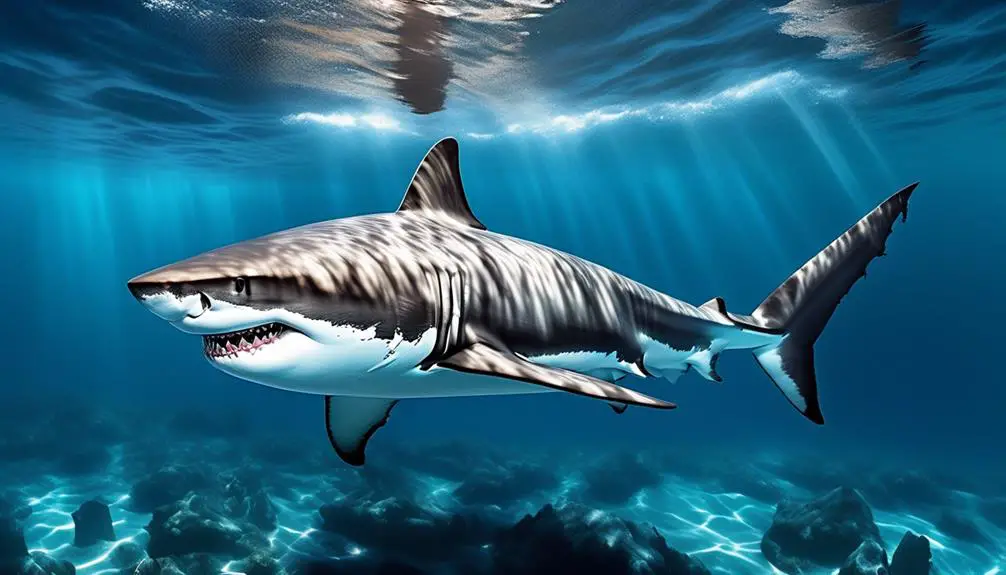
The Great White Shark, known for its role as the most deadly shark species, has a long history of attacks on humans, with over 50 resulting in fatalities out of a total of 333 recorded incidents. This apex predator, scientifically known as Carcharodon carcharias, can reach lengths of up to five meters and weigh over five tons. It’s a formidable creature that instills fear in many. The Great White Shark is commonly found in the Strait of Sicily, where it’s believed to be a breeding hotspot.
Evidence of attacks by the Great White Shark can be traced back to ancient times, with records dating as far back as Roman times. These ferocious predators have a unique combination of size, power, and hunting instincts that make them highly efficient hunters. Their sharp, serrated teeth are perfectly suited for cutting through prey, allowing them to feed on a variety of marine animals, including seals, dolphins, and other sharks.
Despite their fearsome reputation, it’s important to note that attacks on humans are relatively rare. However, when such incidents do occur, they often result in severe injuries or fatalities due to the Great White Shark’s immense size and strength. As a result, it’s crucial for humans to exercise caution when entering waters where these sharks are known to inhabit. Understanding the behavior and habitat of the Great White Shark can help minimize the risk of encounters and ensure the safety of both humans and sharks.
Blue Shark
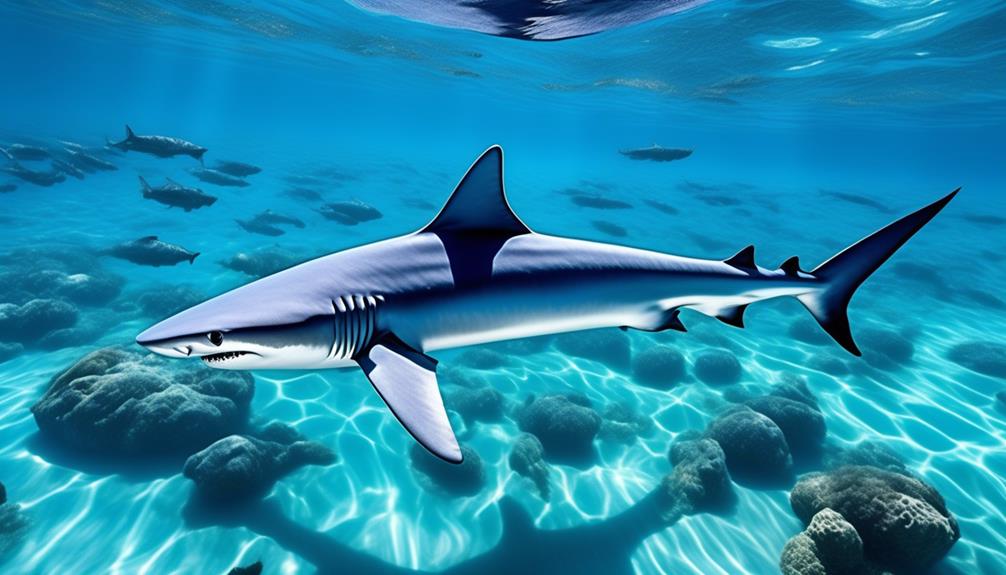
After exploring the Great White Shark, let’s now turn our attention to the Blue Shark, a prominent and populous species found in the Mediterranean basin. The Blue Shark, scientifically known as Prionace glauca, is the most common and abundant shark species in this region. They are easily identifiable by their deep navy-like coloring on the top and a lighter shade of whitish blue on the underbelly.
| Characteristics | Description |
|---|---|
| Size | Medium-sized species, reaching just over three meters at full adulthood |
| Coloration | Deep navy-like coloring on the top, lighter shade of whitish blue on the underbelly |
| Human interactions | Rare incidents of danger to humans, with only around 13 bites in almost 500 years |
| Commercialization | Heavily commercialized for their meat and fins |
Blue Sharks have a slender and streamlined body, allowing them to move swiftly through the water. They are known to migrate long distances, often crossing the Atlantic Ocean. Despite their abundance, they pose little threat to humans. There have been only a few recorded incidents of bites, and these were usually a result of mistaken identity.
Blue Sharks play a significant role in marine ecosystems as they help regulate populations of prey species. They primarily feed on small fish and squid, using their sharp teeth to catch and consume their prey. Unfortunately, they have also become heavily targeted for commercial purposes, with their meat and fins being highly valued in certain markets.
Grey Nurse Shark
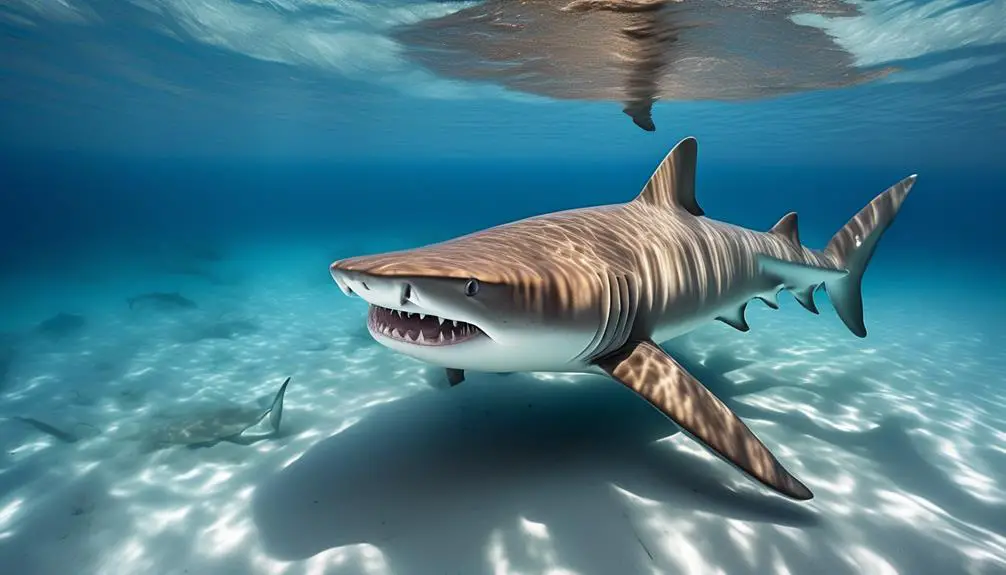
A critically endangered shark species found in western Italy, the Adriatic Sea, southern Spain, and the African Mediterranean Coast is the Grey Nurse Shark, also known as the sand tiger shark. This species, scientifically known as Carcharias taurus, is relatively small, reaching a maximum length of three meters and weighing under 100 kilograms. The Grey Nurse Shark is recognizable by its pointed head and upturned snout.
The Grey Nurse Shark is facing a critical threat due to overfishing and its low reproductive rate. It has been classified as critically endangered by the International Union for Conservation of Nature (IUCN). The species’ population has declined significantly over the years, and conservation efforts are underway to protect its remaining populations.
These sharks inhabit coastal waters, preferring rocky reefs and sandy areas. They’re known to be solitary creatures, but can be found in aggregations during breeding seasons. Their diet consists mainly of small bony fish, crustaceans, and squid.
The Grey Nurse Shark plays an important role in maintaining the balance of marine ecosystems. As apex predators, they help regulate the populations of their prey species, contributing to the overall health and diversity of the marine environment.
It is crucial to raise awareness about the plight of the Grey Nurse Shark and take immediate action to protect this species from further decline. Conservation measures, such as protected areas and fishing restrictions, are essential in ensuring the survival of this critically endangered shark.
Porbeagle Shark
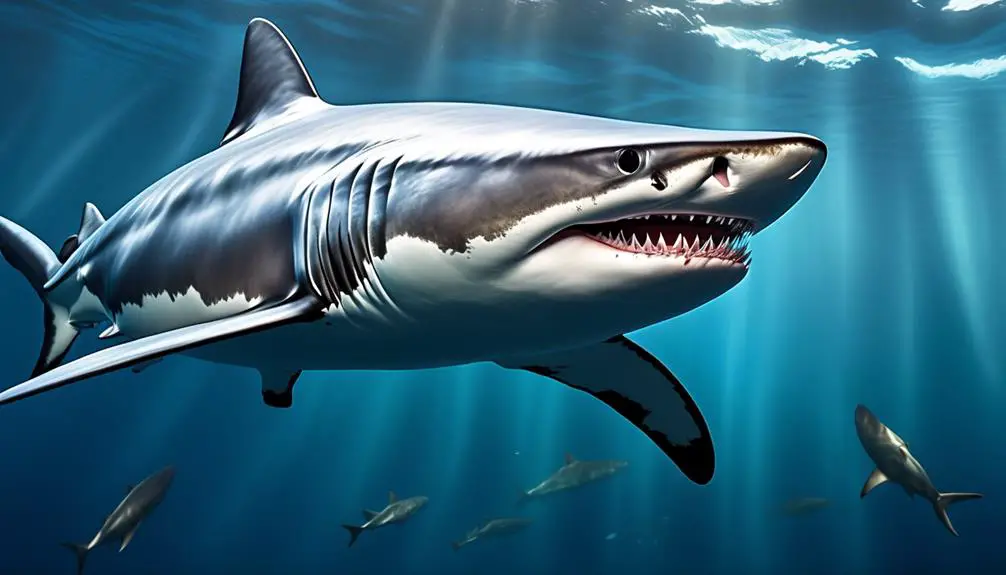
The Porbeagle Shark, scientifically known as Lamna nasus, is a mackerel shark species that can be found in the far North Atlantic and far South Pacific. It has a distinctly stout body with metallic silver coloring, making it easily recognizable.
While it’s primarily recorded in deeper waters, there have been sightings of the Porbeagle Shark in shallower areas and even inside the Mediterranean. Although there have been only three recorded attacks on humans in history, this species is considered potentially dangerous.
The Porbeagle Shark is currently listed as vulnerable due to overfishing for its meat, highlighting the need for conservation efforts.
Habitat and Distribution
Porbeagle sharks, known for their stout bodies and metallic silver coloring, inhabit various regions of the North Atlantic and South Pacific, including shallower waters and even the Mediterranean. These mackerel shark species have been recorded in the far North Atlantic and far South Pacific, but they’ve also been sighted in shallower waters and inside the Mediterranean.
Despite their potential danger to humans, with only three recorded attacks in history, their vulnerability status is attributed to overfishing for their meat. Due to their wide distribution, porbeagle sharks have been impacted by fishing activities in multiple regions.
Understanding their habitat and distribution is crucial for conservation efforts and ensuring the long-term survival of this species.
Threats and Conservation
One of the major threats to the porbeagle shark, a mackerel shark species found in various regions including the Mediterranean, is overfishing for its highly valued meat. The porbeagle shark is known for its stout body and metallic silver coloring. While it has been recorded in shallower waters and inside the Mediterranean, it’s considered vulnerable due to its susceptibility to overfishing.
This species has only been responsible for three recorded attacks on humans throughout history, but its population is still at risk. Conservation efforts are crucial to protect the porbeagle shark from further decline. Implementing fishing regulations and promoting sustainable fishing practices can help ensure the survival of this unique and fascinating species.
Interaction With Humans
As we shift our focus to the interaction between humans and the porbeagle shark, it’s important to understand the potential encounters and implications of this species on human activities and interests.
The porbeagle shark, scientifically known as Lamna nasus, is a mackerel shark species found in the far North Atlantic and far South Pacific. While it isn’t commonly found in the waters surrounding Italy, there have been recorded sightings in shallower waters and inside the Mediterranean.
Although potentially dangerous to humans, with only three recorded attacks in history, the porbeagle shark’s vulnerable status is primarily due to overfishing for its meat. It’s crucial to promote conservation efforts to ensure the survival of this species and maintain a balanced ecosystem.
Common Thresher Shark
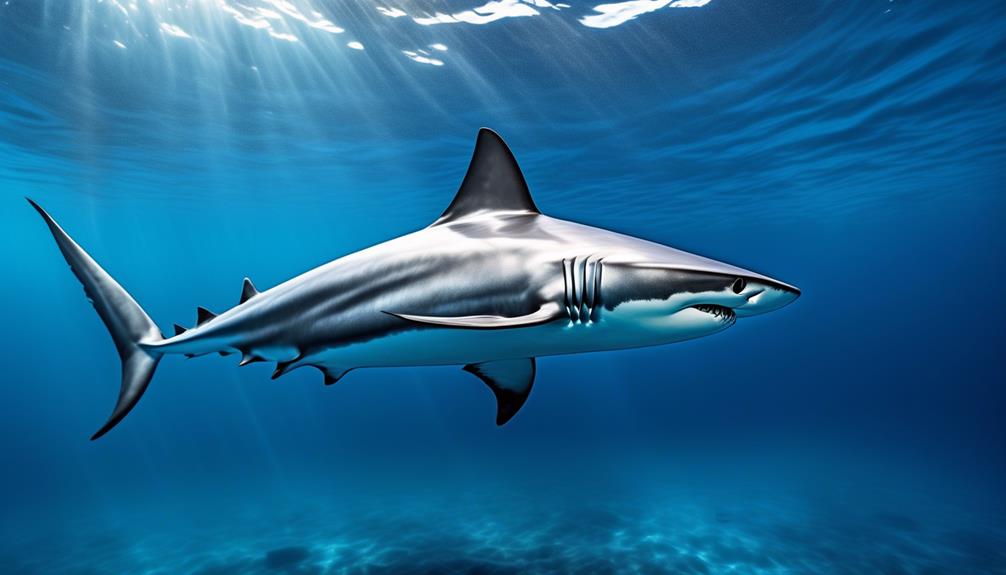
The Common Thresher Shark (Alopias vulpinus) is a fascinating species known for its unique behavior. These sharks are well-known for their long, whip-like tail that they use to stun their prey.
They’re comfortable in both deep ocean waters and shallow reaches, making them adaptable to various habitats.
As for conservation, the Common Thresher Shark faces threats like overfishing, and efforts are being made to protect and preserve their population in the Mediterranean Sea, including Italy.
Thresher Shark Behavior
Thresher sharks, specifically the common thresher shark (Alopias vulpinus), exhibit fascinating and distinctive behaviors that contribute to their survival and hunting strategies in the Mediterranean Sea and surrounding waters.
One notable behavior of thresher sharks is their use of their long, whip-like tail as a hunting tool. They’ll swim in circles around schools of fish, using their tails to stun and immobilize their prey. This behavior allows them to easily catch and consume their food.
Thresher sharks also have the ability to breach the water and leap into the air. This behavior is believed to be a hunting technique, as it allows them to surprise and disorient their prey.
Thresher Shark Habitat
With their preference for deep ocean and shallow reaches, the common thresher shark (Alopias vulpinus) demonstrates a versatile habitat range in the Mediterranean Sea and surrounding waters. These sharks are commonly found in temperate and tropical waters, including the Black Sea and the western Atlantic Ocean. They can be found in both coastal and offshore environments, often near continental shelves and islands.
Thresher sharks are known to inhabit depths ranging from the surface to over 500 meters, although they’re most commonly found in depths between 50 and 200 meters. They’re highly migratory, often traveling long distances in search of food and breeding grounds. The availability of prey, such as small fish and squid, strongly influences their distribution.
Thresher sharks are well adapted to their habitat, with their streamlined bodies and long, whip-like tails enabling them to move efficiently through the water and capture their prey.
Thresher Shark Conservation
In order to ensure the conservation of the Common Thresher Shark (Alopias vulpinus), it is important to implement effective management strategies and promote awareness of the threats facing this species. The Common Thresher Shark is found in the Mediterranean Sea, including Italy, as well as the Black Sea. This species is comfortable in both deep ocean and shallow reaches, using its long, whip-like tail to stun prey. Growing up to six meters in length, the Common Thresher Shark is a majestic creature that requires protection. To better understand the conservation efforts for this species, the following table provides an overview of the key management strategies and threats that are currently impacting the Common Thresher Shark:
| Management Strategies | Threats |
|---|---|
| – Establishing protected areas and marine reserves | – Overfishing and bycatch |
| – Implementing fishing regulations and quotas | – Habitat degradation |
| – Promoting sustainable fishing practices | – Climate change and ocean acidification |
| – Conducting research and monitoring populations | – Pollution and marine debris |
| – Educating the public and raising awareness | – Illegal trade and finning |
Mako Shark
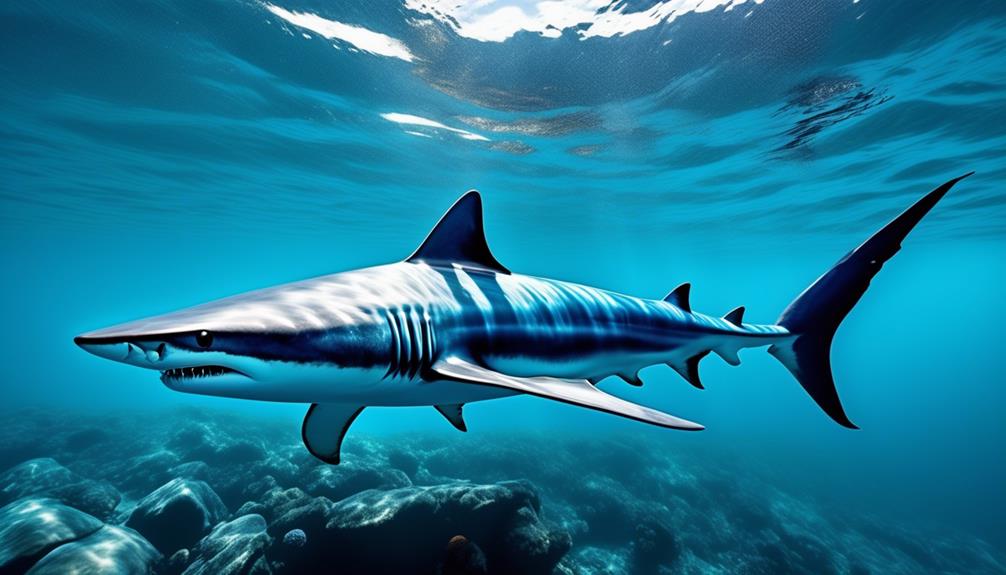
The Mako Shark, also known as Isurus oxyrinchus, is a highly agile and powerful predator found in various oceans around the world. With its streamlined body and long, slender tail, it’s built for speed and maneuverability. Makos are known for their ability to reach impressive speeds of up to 45 miles per hour, making them one of the fastest sharks in the ocean. They’ve a distinctive appearance, with a dark blue or metallic gray coloration on their dorsal side and a lighter shade on their ventral side.
Makos are voracious hunters, primarily feeding on fish and cephalopods. Their sharp, serrated teeth enable them to tear through their prey with ease. They’re also known to be opportunistic feeders, often scavenging on carcasses or preying on injured or weak animals. Despite their powerful physique, Makos aren’t considered a significant threat to humans. While they may investigate and bite when provoked or mistaken for prey, there have been relatively few recorded incidents of Mako Shark attacks on humans.
In Italy, Makos can be found in the Mediterranean Sea, particularly in the southern regions. They’re known to migrate through the Strait of Sicily, which serves as a breeding hotspot for various shark species. The presence of Makos in Italian waters is a testament to the rich biodiversity of the Mediterranean and underscores the importance of conservation efforts to protect these magnificent creatures.
Basking Shark
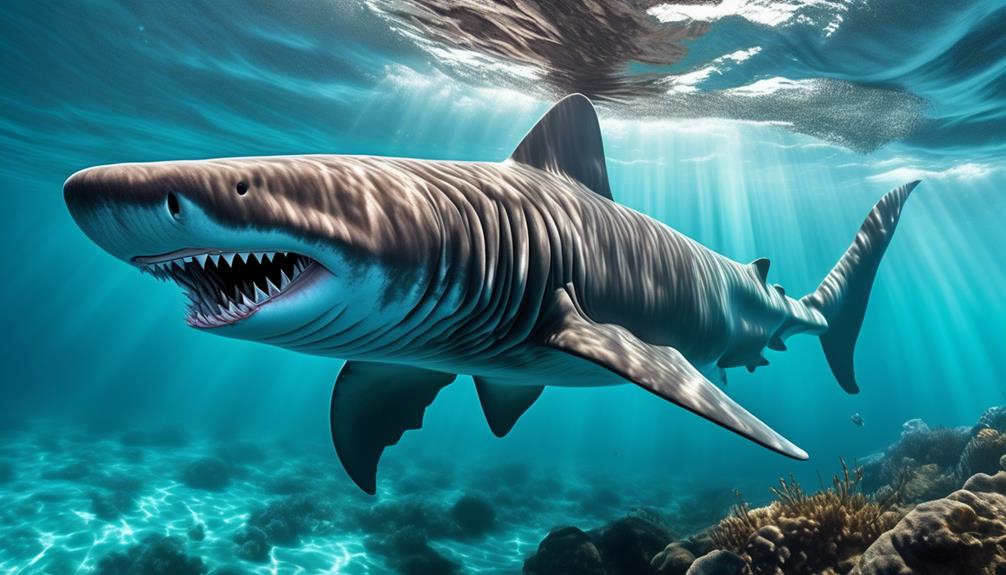
The Basking Shark (Cetorhinus maximus) can be found in the waters surrounding Italy, particularly in the Mediterranean Sea. It’s the second-largest fish species in the world, reaching lengths of up to 10 meters and weighing over 5 tons.
Despite its imposing size, the Basking Shark is a filter feeder, primarily consuming plankton and small fish.
Due to its gentle nature and low reproductive rate, conservation efforts are necessary to protect this vulnerable species from overfishing and habitat destruction.
Basking Shark Habitat
Basking Shark, a large and gentle species, can be found in the waters of Italy, specifically in the Mediterranean Sea. These sharks have a wide habitat range, as they’re known to inhabit both coastal and offshore waters. Basking Sharks are commonly found near the surface of the water, where they feed on plankton and small fish.
They’re frequently seen in areas with high concentrations of zooplankton, such as near coastal upwelling zones or in areas with strong tidal currents. Basking Sharks are also known to migrate seasonally, following food sources and water temperatures. During the summer months, they can be observed in the waters around Italy, where they provide a unique opportunity for divers and marine enthusiasts to witness these magnificent creatures in their natural habitat.
Basking Shark Characteristics
A highly distinctive shark species in Italy’s waters, known for its wide habitat range and gentle nature, is the Basking Shark. With its scientific name Cetorhinus maximus, this species is the second largest shark in the world, reaching lengths of up to 10 meters and weighing around 5,000 kilograms.
The Basking Shark has a unique appearance, characterized by its enormous mouth and large gill slits. Its body is covered in rough, greyish-brown skin, and it has a crescent-shaped tail fin.
Despite its size, the Basking Shark is a filter feeder, consuming large quantities of plankton and small fish through its gaping mouth while swimming slowly near the surface. This species can be found in both coastal and offshore waters, often seen basking near the surface to regulate its body temperature.
It’s a peaceful shark, posing no threat to humans.
Basking Shark Conservation
One of the key aspects in the conservation efforts for the Basking Shark species involves understanding its ecological role and implementing effective management strategies. Basking sharks play a crucial role in maintaining the health and balance of marine ecosystems. As filter feeders, they consume large quantities of plankton and other small organisms, thereby helping to regulate populations and prevent overgrowth.
To ensure the long-term survival of these sharks, various conservation measures have been put in place. These include the establishment of protected areas where fishing activities are restricted, the implementation of fishing gear modifications to reduce accidental bycatch, and the promotion of public awareness and education programs.
Additionally, international collaborations and research initiatives are being conducted to gather more data on their population size, distribution, and migratory patterns. By taking these actions, we can contribute to the conservation of the Basking Shark species and safeguard their important ecological role in the marine environment.
Hammerhead Shark
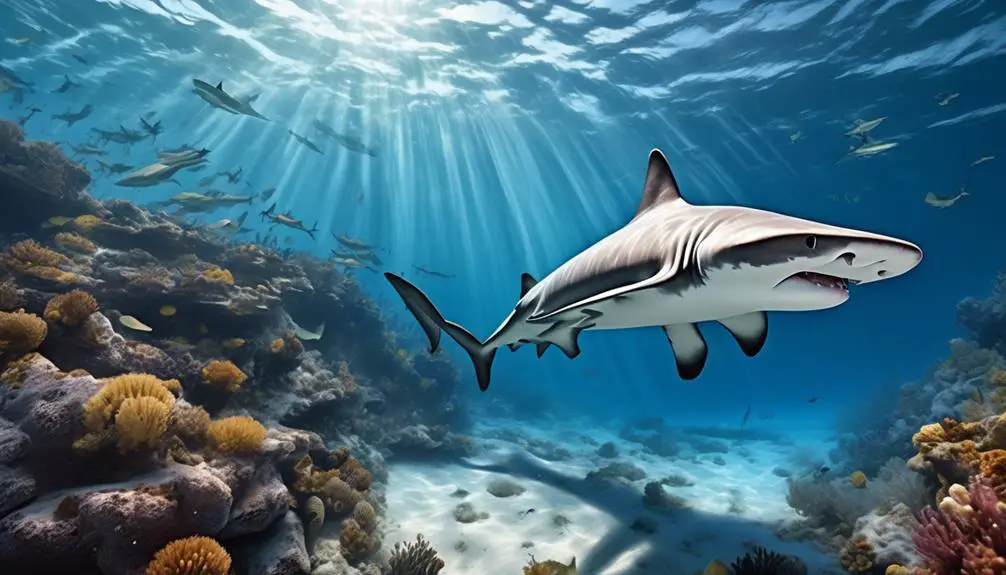
The Hammerhead Shark (family Sphyrnidae) is a unique and fascinating species known for its distinctive hammer-shaped head, which is believed to enhance its sensory capabilities. These sharks can be found in various locations around the world, including the Mediterranean Sea, including Italy.
Hammerhead sharks are known for their highly developed senses and unique hunting strategies. The wide-set eyes and placement of their nostrils on the outer edges of their ‘hammer’ allow for a greater field of vision and improved detection of prey. Additionally, their specialized electroreceptive organs called ampullae of Lorenzini, located in the hammer-shaped head, enable them to detect the electrical signals emitted by their prey.
There are several species of hammerhead sharks, including the Great Hammerhead (Sphyrna mokarran) and the Smooth Hammerhead (Sphyrna zygaena), that can potentially be found in Italian waters. These sharks are typically found in warmer, coastal areas, and are known to migrate to different regions in search of food and suitable breeding grounds.
While hammerhead sharks are generally not considered a threat to humans, caution should still be exercised when encountering them in the water. Like all sharks, they’re wild animals and should be respected from a safe distance.
It’s important to remember that sharks play a vital role in maintaining the balance of marine ecosystems and should be protected and conserved for future generations to appreciate and study.
Shortfin Mako Shark
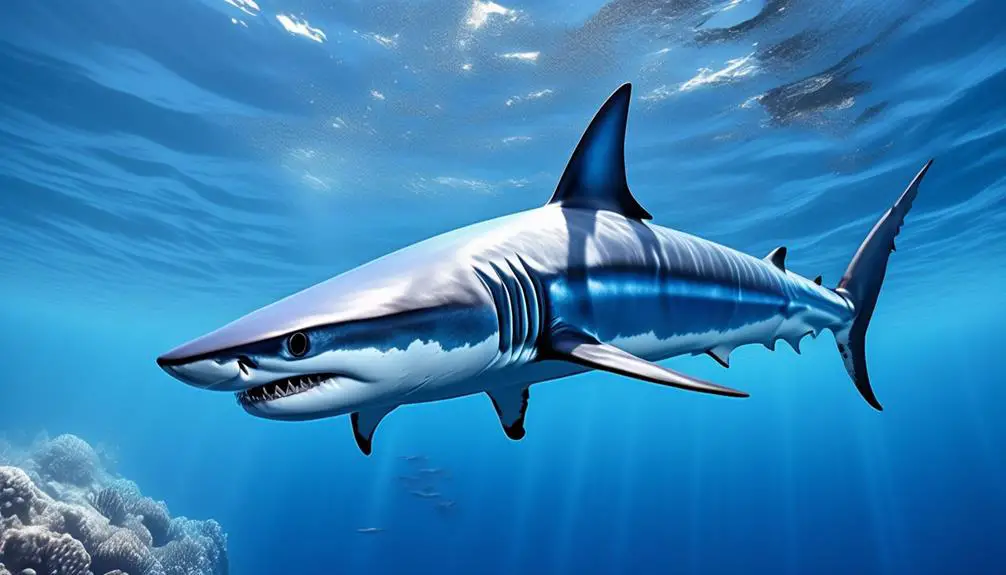
The Shortfin Mako Shark (Isurus oxyrinchus) is a highly agile and powerful species known for its incredible speed and distinct appearance. It’s one of the fastest swimming sharks in the ocean, capable of reaching speeds up to 45 miles per hour. With its streamlined body and long, slender tail, the Shortfin Mako is built for speed and maneuverability.
This species is easily recognizable by its pointed snout, large eyes, and crescent-shaped tail. It has a blue-black coloration on its back and a white underbelly, which helps it blend in with the surrounding water. The Shortfin Mako Shark also possesses a set of sharp, serrated teeth that allow it to efficiently capture and consume its prey.
Shortfin Makos are found in both temperate and tropical waters worldwide, including the Mediterranean Sea. While they prefer offshore habitats, they’re known to venture closer to shore in search of food. Their diet mainly consists of smaller fish, squid, and occasionally marine mammals.
Despite their power and speed, Shortfin Makos are generally not considered a threat to humans. However, caution should still be exercised when encountering these sharks, as they’ve been known to react defensively if provoked or cornered.
Silky Shark
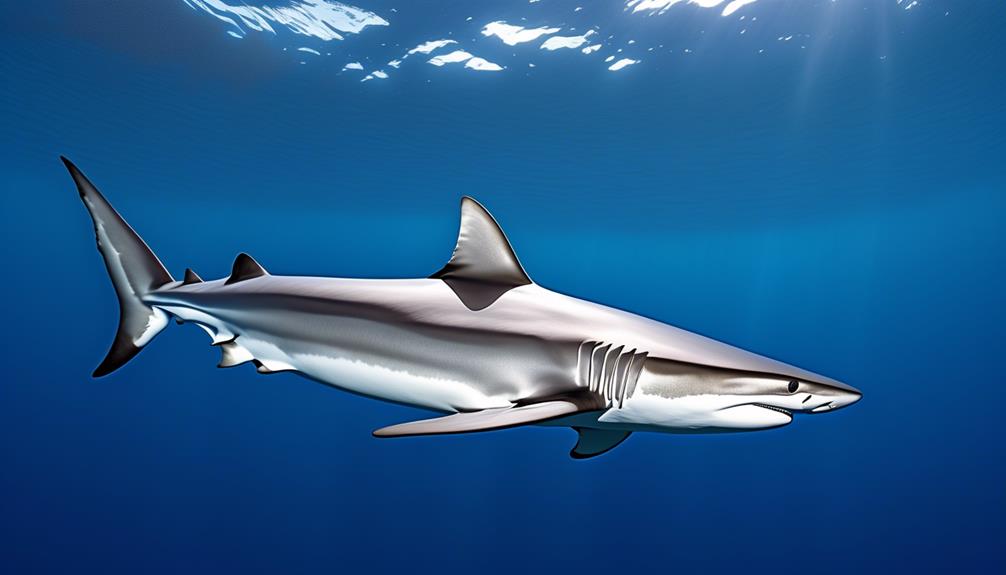
Silky sharks (Carcharhinus falciformis) are a species of shark known for their smooth, velvety skin and slender body shape. They are found in both tropical and warm temperate waters, including the Mediterranean Sea, where they occasionally make appearances. Silky sharks are classified under the Carcharhinidae family, which includes other well-known species such as the bull shark and the tiger shark.
| Silky Shark (Carcharhinus falciformis) | ||
|---|---|---|
| Average Length | 2.5 – 3.5 meters | 8.2 – 11.5 feet |
| Average Weight | 150 – 200 kilograms | 330 – 440 pounds |
| Diet | Small fish, squid |
Silky sharks possess a streamlined body, allowing them to swim swiftly through the water. Their coloration is typically dark grey or brown on the dorsal side, fading to a lighter shade on the ventral side. They have a long, slender tail and large pectoral fins, which aid in their efficient movement. These sharks are known for their voracious appetite and are often found in areas where food is abundant, such as near upwelling zones or near schools of fish.
While silky sharks generally do not pose a threat to humans, caution should still be exercised when encountering them. They have been known to become aggressive if provoked or if there is a source of food nearby. It is important to maintain a safe distance and avoid any actions that may be perceived as a threat. Silky sharks play an important role in marine ecosystems, and their presence in the Mediterranean adds to the biodiversity of the region.
Sandbar Shark
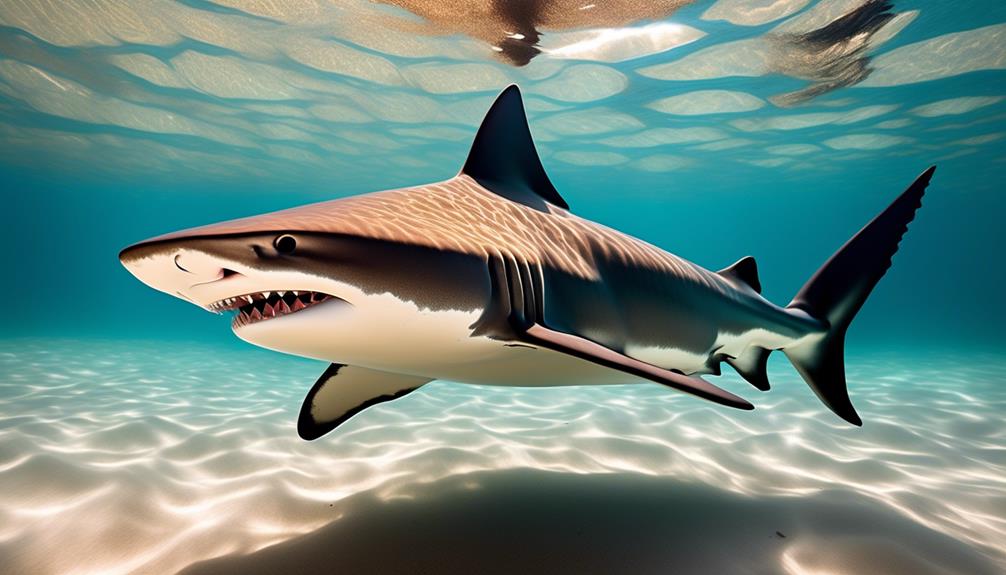
With a shift from silky sharks, let’s now explore the sandbar shark (Carcharhinus plumbeus), a species commonly found in the Mediterranean Sea and known for its distinctive appearance and behavior.
The sandbar shark, also known as the brown shark, is a large species that can reach lengths of up to 2.5 meters and weigh over 100 kilograms. Its body is stout and cylindrical, with a rounded snout and small eyes. One of its most notable features is its high, triangular dorsal fin, which is larger than those of other shark species found in the Mediterranean.
Sandbar sharks are typically found in coastal areas, particularly in sandy or muddy bottoms, hence their name. They’ve a preference for shallow waters, but can also be found in deeper areas up to 200 meters. Their diet consists mainly of small fish and crustaceans, which they capture using their sharp, serrated teeth. Unlike some other shark species, sandbar sharks aren’t known to pose a significant threat to humans. They’re generally non-aggressive unless provoked or threatened.
In terms of reproduction, sandbar sharks are viviparous, meaning they give birth to live young. The females have a gestation period of approximately one year and can give birth to as many as 14 pups at a time. The pups are born fully developed and are around 50 centimeters in length.
Blacktip Shark
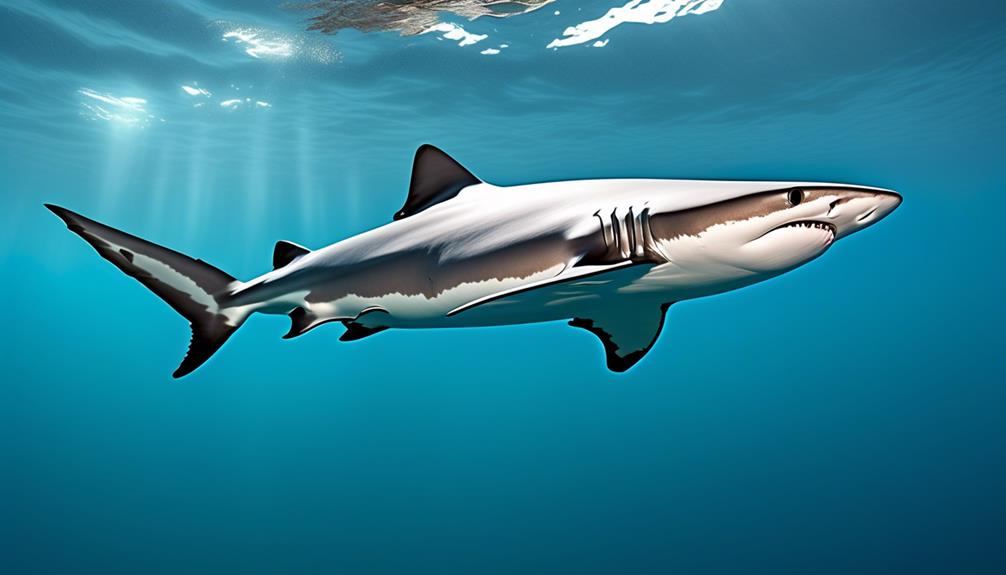
A highly adaptable predator, the Blacktip Shark (Carcharhinus limbatus) is a species commonly found in the Mediterranean Sea, known for its distinctive appearance and behavior. This shark gets its name from the black tips on its fins, which are especially prominent on the first dorsal fin and pectoral fins. The body of the Blacktip Shark is slim and streamlined, allowing it to swim swiftly through the water. It typically reaches lengths of 5 to 6 feet and weighs around 40 to 50 pounds.
The Blacktip Shark is characterized by its energetic and acrobatic behavior, often seen leaping out of the water. It’s known for its hunting technique of herding and chasing schools of fish, using its sharp teeth to capture its prey. While it primarily feeds on small fish, it may also consume crustaceans and cephalopods.
In terms of habitat, the Blacktip Shark prefers warm coastal waters, making it well-suited for the Mediterranean Sea. It can be found along the coastlines of Italy, particularly in the southern regions. This species is known to migrate, following the seasonal movements of its prey.
While the Blacktip Shark is generally not considered dangerous to humans, it’s important to exercise caution when encountering any shark in their natural habitat. It’s advisable to avoid disturbing or provoking them, as they may exhibit defensive behavior.

Erzsebet Frey (Eli Frey) is an ecologist and online entrepreneur with a Master of Science in Ecology from the University of Belgrade. Originally from Serbia, she has lived in Sri Lanka since 2017. Eli has worked internationally in countries like Oman, Brazil, Germany, and Sri Lanka. In 2018, she expanded into SEO and blogging, completing courses from UC Davis and Edinburgh. Eli has founded multiple websites focused on biology, ecology, environmental science, sustainable and simple living, and outdoor activities. She enjoys creating nature and simple living videos on YouTube and participates in speleology, diving, and hiking.

